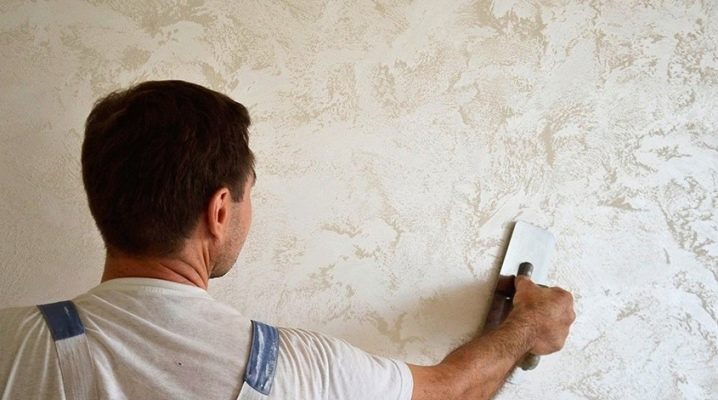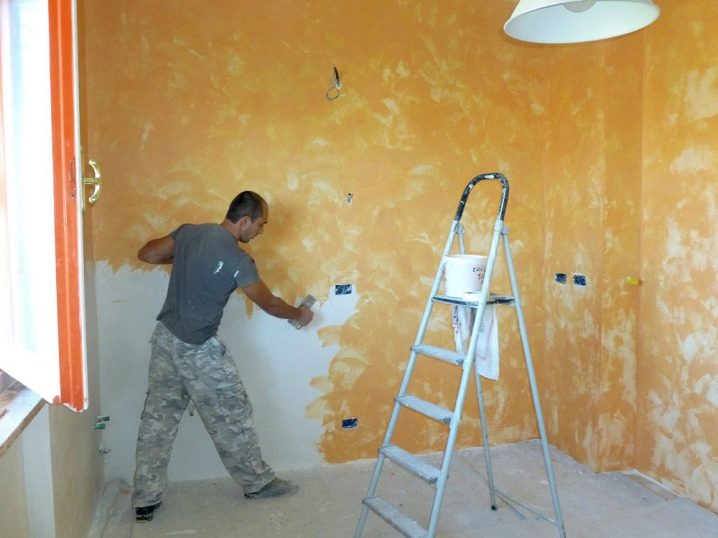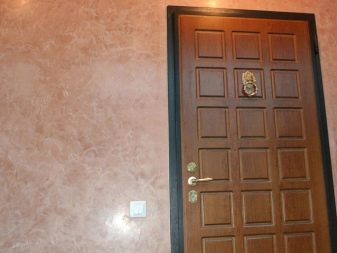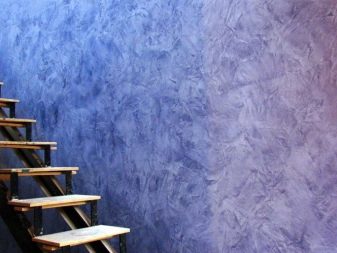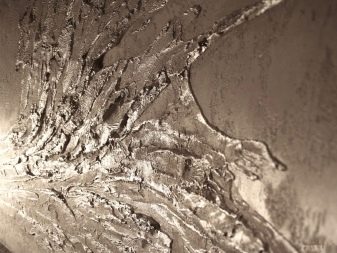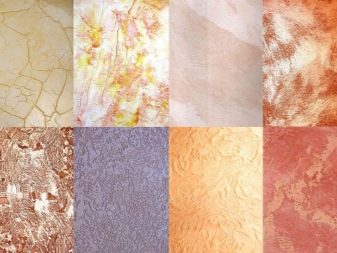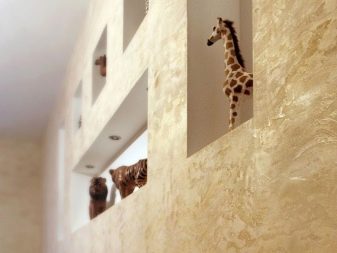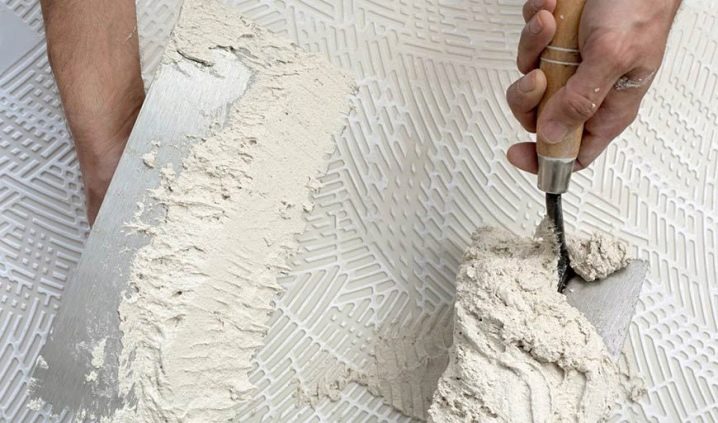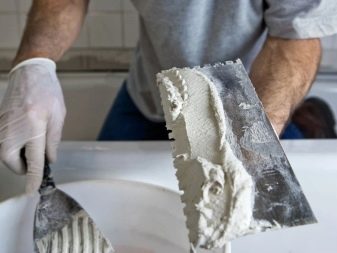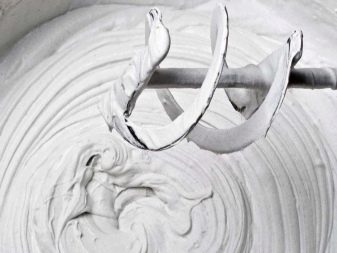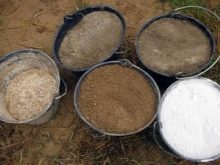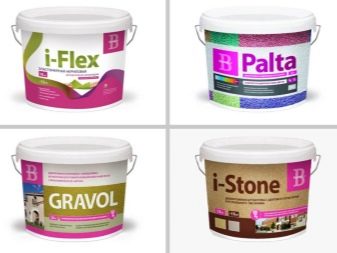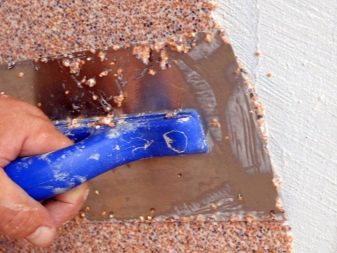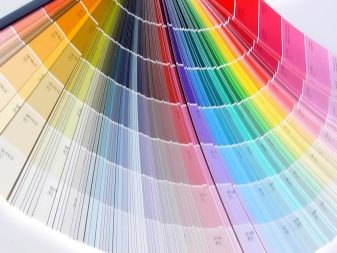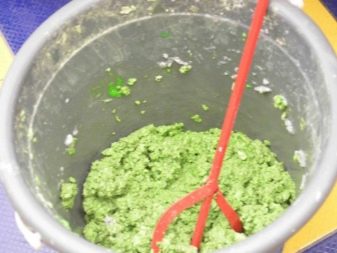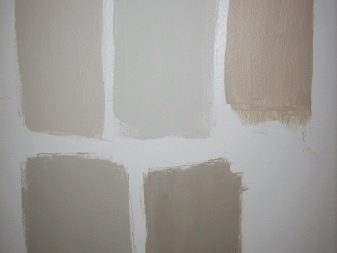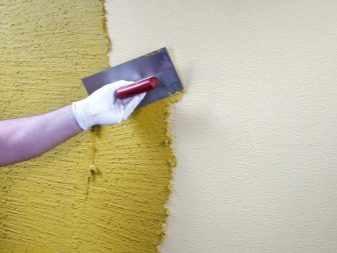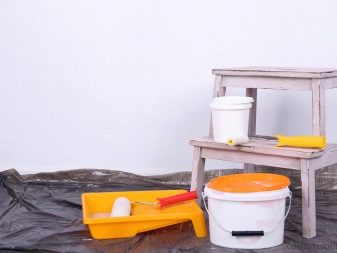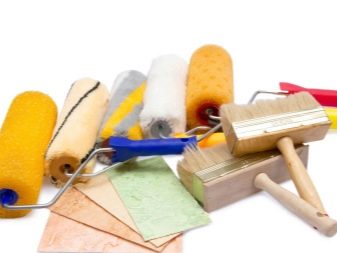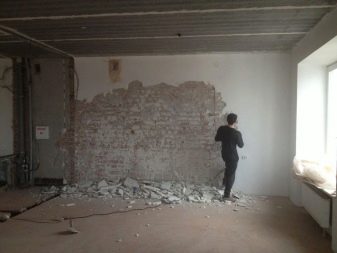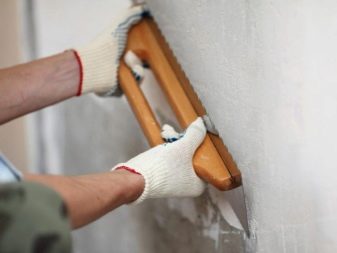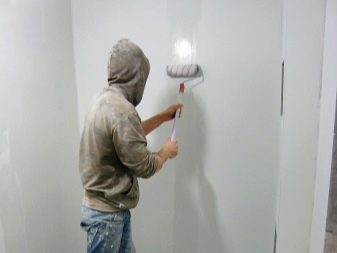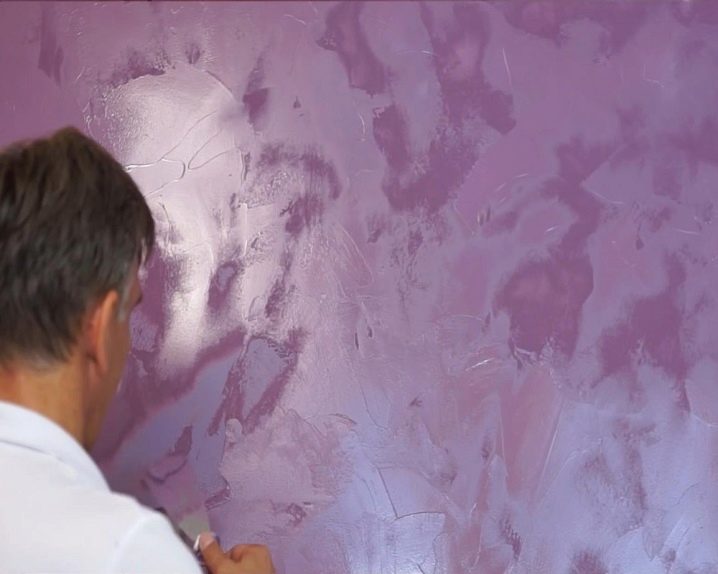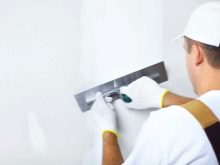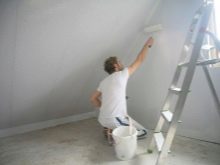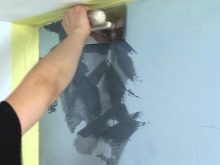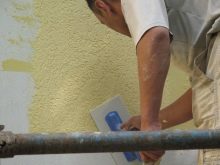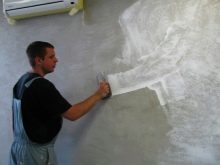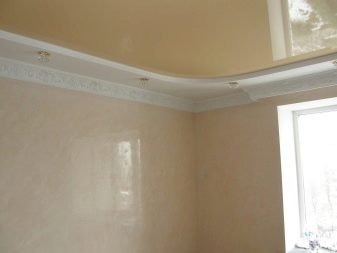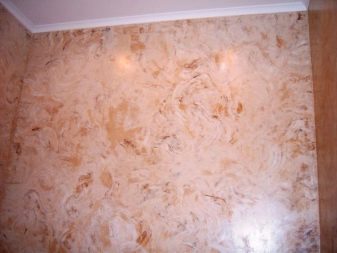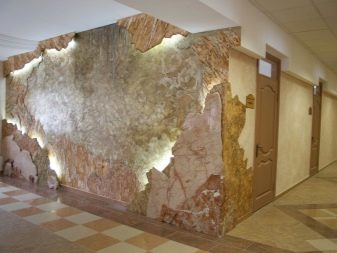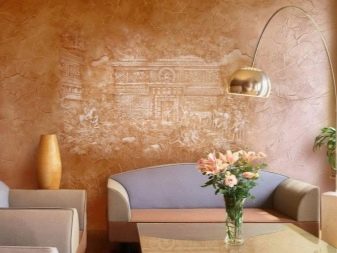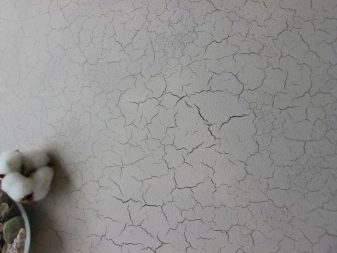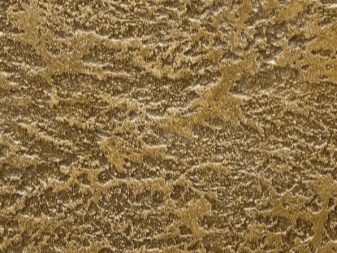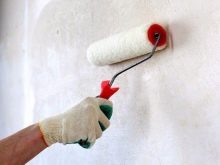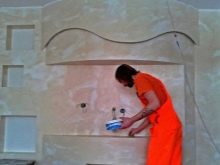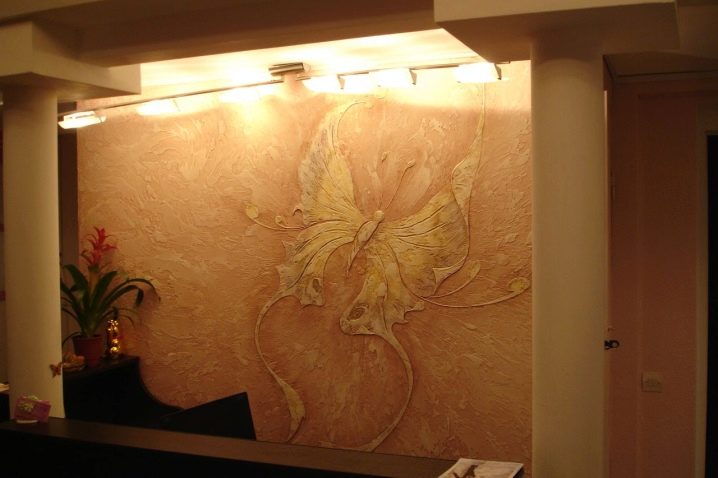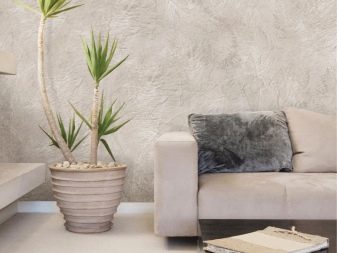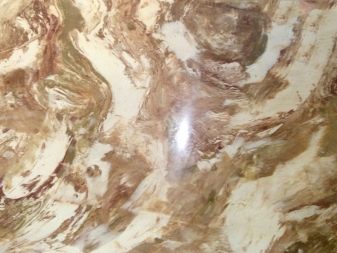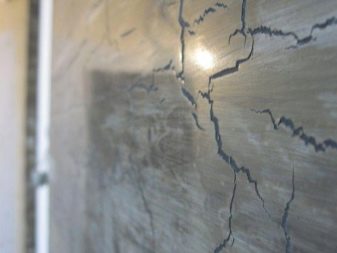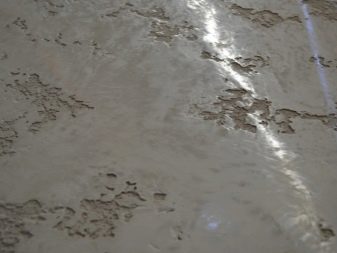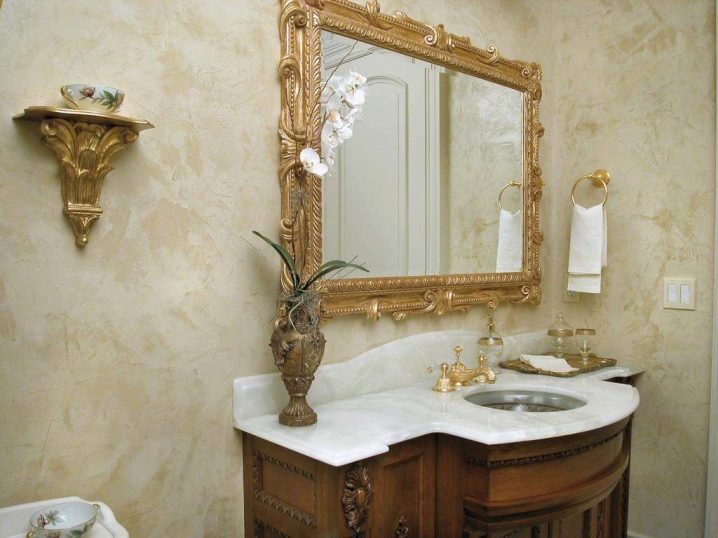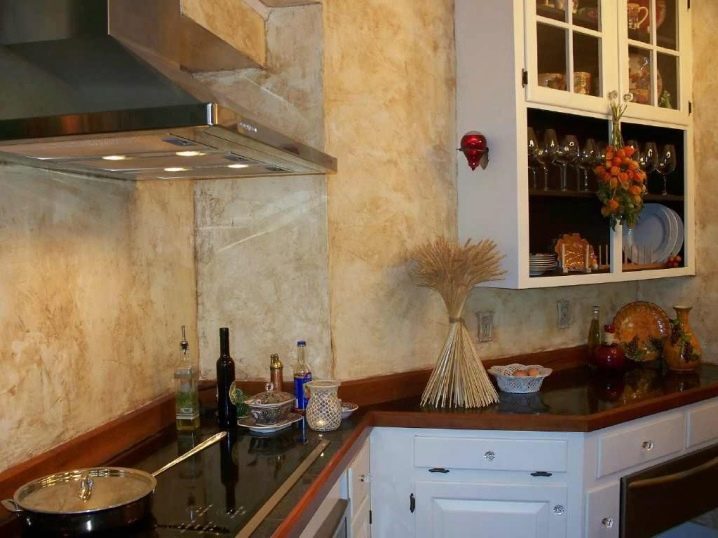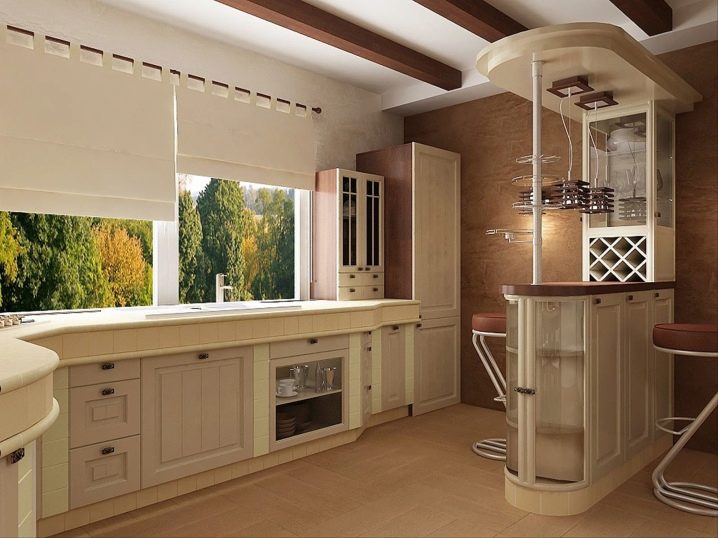Applying Venetian plaster do it yourself
Venetian plaster appeared long ago, it was used by the ancient Romans. In Italian, it is called stucco veneziano. Everyone knows that marble was the most popular at that time, and decoration was carried out using its waste - stone dust and small stone fragments. There are no external differences in such finishing from natural marble or other material, and it is much easier to handle it.
What it is?
Venetian plaster is a finishing layer for walls, ceilings or facades of a building. It has excellent decorative characteristics.
The price is high, but the effect is significant: the room acquires respectability and special refinement.
There are several types:
- Veneto - imitates marble.The simplest variety in terms of application and care relative to others. Use of a sponge and plain water is allowed for cleaning.
- Trevignano - to create a coating using up to 12 layers. Polymers are added to the compound for binding. Favorably emphasizes classic vintage furniture in the Baroque style or their modern counterparts.
- Marbello - is a small glossy blotches on a matte background. When applied using a mixture of different colors. Often used together with substances that increase the hydrophobicity of the coating.
- Encausto - characterized by the fact that the plaster is similar to semi-gloss or glossy granite. Requires waxing after drying.
We list the advantages of Venetian plaster:
- strength - does not form cracks, withstand significant external influences;
- has a water-repellent effect after treatment with special wax, so it can be used in rooms with high humidity - bath, sauna, swimming pool, bath;
- environmentally friendly material, safe for humans, since the main component is crushed natural stone;
- perfectly reflects the rays of light falling on the surface - the “glow effect”;
- fireproof material;
- the mixture can be made at home.
The disadvantages include the high price and special requirements for the base on which the decorative layer will be applied.
Features and composition of plaster
In antiquity, only natural components were included in Venetian plaster. Today, acrylic is often used as a binder instead of lime. Synthetic material allows to increase plasticity and prevents the appearance of cracks after drying of the solution.
Components of the mixture:
- stone dust (the smaller the fraction, the better);
- coloring matter (color);
- binders;
- emulsion based on acrylic or water;
- sometimes added gypsum, other additives;
- wax is used to protect against moisture and shine.
Plaster in finished form can have a rough or absolutely smooth surface, imitate various textures. The peculiarity of the application implies a thorough preparation of the foundation for plaster. There should be no irregularities, drops, chips and cracks, otherwise they will become noticeable after the solution dries.
The use of onyx, malachite, marble, granite, quartz and the like in a mixture of natural crumbs allows you to create magnificent coatings that are not inferior in beauty to natural stone. At the same time the surface has no joints, it looks like a single monolith.The picture of the walls treated with such plaster is easy to restore, change their texture.
Calculation of the amount of material
It is possible to calculate plaster consumption per 1 m2 using a simple formula:
- Calculate the total area of all treated surfaces with a small margin. Layer thickness and consumption per square meter are found on the packaging.
- Of course, the required amount of materials directly depends on the number of layers, but the average consumption is 0.5 kg / m2.
Formula:
N = R x S x K,
Where:
N is the amount of plaster,
R is its quantity per square meter,
S is the total surface area
K is the number of layers.
Preparation of the mixture
The plaster is made of three parts: stone crumb, a bonding compound (slaked lime or various acrylic resins can be used) and color schemes. This plaster is used on walls and ceilings made from virtually any material.
You can purchase materials:
- stone crumb - in the workshop of the relevant profile;
- hydrated lime, resins and colors - in retail chains.
It is important to know that you can not just come to the store, buy and apply the finished mixture for Venetian plaster on the wall.Requires a creative approach in its preparation. Having a certain amount of free time and energy Venetian plaster can be prepared with your own hands according to several recipes.
Stone crumb
Coloring and texture can be anything: imitate leather, silk, stone. Such plaster turns translucent, which allows to achieve a unique play of light.
Work order:
- Three parts of sand (clean) are mixed with three parts of gypsum putty and one part of building gypsum.
- We mix everything with water to obtain the desired viscosity.
- When mixing, add plaster putty until we get a homogeneous mass.
- Paint is added to the mixture before applying to the walls and ceilings.
If you bought the mixture in the store:
- follow the manufacturer's instructions, they are attached;
- Remember that the mixture at the end of cooking should be of medium thickness;
- when the mixture is ready, leave it for a quarter of an hour, after which it must be mixed again;
- stirring is strictly not recommended if the air temperature is below + 10 ° C;
- one batch can cover such a surface areaso that the border with the plaster from the next batch of mortar was not visible.
Tinting
Giving the color of the mixture is another important stage in the preparation of plaster. We select the color range. You can use the so-called "tinting fan", which contains both colors and many of their shades. Useful tools: a sheet of white paper, a place for test mixes to determine the shade, spatula and dyes. There must also be some white Venetian plaster and the right colors.
What should be done:
- Choose the main dye and add to the base - white plaster.
- Stir with a spatula until uniform color.
- Put a little colored mixture on the paper and compare it with the sample on the “fan”, determine what color to add / remove. If necessary, this stage is repeated several times.
It should be borne in mind that the color after drying will be approximately a tone and a half lighter than with samples.
Tools for work
- a mixture of Venetian plaster;
- primer;
- wax;
- putty;
- roller;
- special trowel used for Venetian plaster;
- spatulas of different widths;
- sandpaper of varying degrees of grit;
- grinding machine;
- technical hair dryer;
- centimeter / tape measure;
- masking tape;
- rags / suede / silk;
- construction mixer (you can pick up any other device);
- place for mixing the components of the mixture;
- stencils.
Surface preparation
- Remove the remaining coating from the wall or ceiling, all the pollution after previous decorating: oil, dust, wallpaper glue on the walls, putty, and the like.
- Explicit irregularities are eliminated by filling them with cement and sand, minor ones - by filling.
- We apply a grinder, sandpaper with different grains.
- We put the first layer of putty, let it dry and put a layer of fine final putty on top.
- Rubbed with sandpaper.
- Later, we soak the wall twice with a primer. Do so with breaks of 3-4 hours in order to increase the permeability of the layers.
- You may need to apply another layer of tinting to the plaster was one tone with a primer.
Application Methods
It should be noted that the invitation of hired specialists who will not work for free, and the finishing itself with Venetian plaster is expensive.Independent production of the solution and the application of simple textures can save a lot, and the result justifies all the efforts. There are certain rules and technology of application of the Venetian.
Step-by-step instruction:
- Apply as thin as possible layer of facing putty and wait 6-8 hours until it is completely dry.
- Apply primer evenly. The ratio of water / mixture - 1 to 7. Most likely, it will be correct to put 2 layers of primer.
- We begin to apply the plaster from the upper part of the wall with slight arc-like movements down and to the side. In contrast to the primer mixture is applied unevenly.
- It is necessary to monitor the saturation of the color of the painting, so that later there is no need to add layers of plaster to correct the discrepancies in the color scheme.
- The initial layers impose a wide spatula short movements in an arc.
- After the process is complete, we look through the layer thickness, try to minimize it.
- Again, we take in hand a wide spatula, smooth down the Venetian from the bottom up and from top to bottom, crosswise.
- We polish the whole area with a float at an angle of 10 degrees.
- If there is a socket on the wall, the surface around it is machined away from it. The spatula of smaller width or a grater is used.
- Any defects / defects / layer thickness noticed - we fix it while the Venetian stays wet.
- If necessary, process the surface with wax - polish.
Here are a few different techniques for imitating Venetian application:
Venetian plaster imitating marble
- Apply plaster chaotically, covering the entire surface;
- We give texture, while the mixture remains wet, with the help of a trowel;
- We pause for a couple of hours, during which we prepare 2-4 varieties of the mixture with additives of various colors. Apply them gradually with a spatula or trowel of smears across the entire surface along a long arc.
- Dried for about a day. You can repeat this procedure several times, leaving about a day for drying between each cycle.
- Thrice we polish the wall with various nozzles with the help of a sander.
- The next stage is ironing. For ironing it is necessary to press the trowel to the surface with considerable force.
- At the end we process the wall / ceiling with varnish / wax.
Venetian plaster imitating the classic version
- Apply the first layer in the same way as when imitating marble. We pause for a couple of hours to dry.
- We treat with trowel excess plaster.
- We conduct iron formation until we reach the effect of metallic luster.
- We prepare one-color plaster, we put it on, we return to the iron-making process again, after which we wait less time - 30-40 minutes is enough.
- With further layering follow the same sequence.
- We use the grinder with three different nozzles only when the surface is completely dry.
- Cover the wall with wax / varnish.
Venetian plaster imitating craquelure
Craquelure in French means "antique".
Procedure:
- Spatula randomly impose a thick layer of plaster.
- We heat the surface with an electric dryer so that cracks appear on the plaster due to contrasting temperature changes.
- When the cracks appear, wait for drying - about 24 hours.
- Venetian finish is applied a thin layer and must have a color different from the previous one.
- We finish the process with the usual three-stage grinding with iron.
Venetian plaster imitating cork tree
- We start with a layer having different colors.It is prepared by incomplete mixing of solutions of two or three different tones.
- Use a trowel or a wide spatula to apply a thick layer on the wall, then carefully dry it with a building dryer.
- We use a hair dryer at different distances from the wall to obtain a non-uniform texture - characteristic cracks.
- We pause for two days for further drying.
- We apply a second layer of plaster, it should have a shade of color that is different from the first layer.
- Grind the plaster sandpaper or grinder.
- Cover the wall with wax or varnish.
Textured Venetian plaster
- Cover the surface of the wall / ceiling with a water-dispersion primer.
- Give the coating to dry and wear a layer of covering primer.
- Take a break for a couple of hours.
- We apply the plaster with a thin even layer using a fur roller and leave to dry for three to four hours.
- Use a narrow metal trowel to level the surface.
- The second layer of Venetian impose a trowel.
- Dry the surface for six hours.
- Repeat the removal of irregularities.
- Add a finish lacquer to the Venetian to create the final coating using a mixer or drill with a nozzle.
- Expect 6 hours to dry.
- Ironing with a trowel gives the effect of metallic luster.
- Polishing - impose a layer of wax.
Useful recommendations
The choice of Venetian plaster is a matter of taste. It tends to seem similar to the texture of stone, pearls, surfaces covered with leather, wood, cloth. If desired, the texture can be corrected, or even changed. The wall or ceiling may become dull or glossy. Consider the purpose of the room, the style of which you want to change.
If you want to finish the metal with plaster, it will need to be further processed with synthetic synthetic resins to prevent corrosion. Over time, it will become partially visible even through the translucent layer of plaster.
The final wax coating is needed to ensure moisture resistance. It is used for bathrooms, baths, or kitchens when they are finished with Venetian plaster. The only note in this case - do not forget that the wax tends to darken over time, so avoid its too large volumes.
If successful, you will have a beautiful textured, moisture-resistant, hard and smooth surface.Plaster can serve you up to 15 years or more. Another advantage is the ease of selecting the desired color and texture to your furniture.
Beautiful examples in the interior
Looks great in the shower version of Veneto filler Veneto. The surface, simple on an embodiment of a plan, perfectly imitates noble polished marble.
Sandy warm tones of this design decision highlight the classic style of the dining area. The laconism of the colors in the interior is compensated by the complexity of the shades of the decorative finish.
Modern interpretation of Venetian plaster for urban kitchen interior. Clear intersecting lines and deep gray hues lend brutality to the soft and warm appearance of the rest.
Another example of a modern kitchen solution. The restrained beauty of the plastered surfaces, the clarity of the lines do not contradict the natural structure of the tree. The emphasis is shifted to the soft outlines of the false beams, leaving space for the apartment owners. They themselves must become part of the design intent.
How to apply the Venetian plaster the hands, look in the following video.
